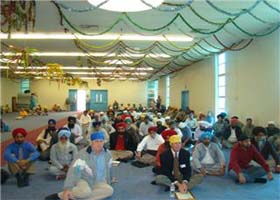Honour and Glory to Punjabi Pioneers
By Dr. Amrik Singh writes from Sacramento
South Asia Post, Issue 51 Vol III, November 15, 2007
Three-day celebrations of 28th Annual Sikh Parade in Yuba City started with fireworks on Friday, November 2, 2007. An open seminar was held on Saturday afternoon. Lieutenant Governor John Garamendi inaugurated the seminar and congratulated organizers for their efforts to handle Sutter County’s largest religious festival. Dr. Bruce L. Brack Professor of Anthropology and International Studies of Pacific University Stockton delivered the keynote address. Sukhraj Singh, an American born Sikh spoke on challenges he had to face to keep his identity intact. Rori Ramirez, vice mayor of Yuba City shared his impressions of working with Sikhs. City Mayor John Miller talked about the significance of annual Sikh Parade and enthusiasm of Yuba City residents. Dr. Jasbir Singh Kang, M.D. introduced Professor Bruce La Brack and informed the audience of his intellectual stature and contribution. Sutter County supervisor Jim Whiteaker told about his long association with Sikhs and how incredible was the process of preparing food for such a big gathering. Later Yuba City’s Sikh City Council members Tej Mann and Kash Gill addressed the audience saying how proud they were to represent the Sikh community in the city council.
 Professor Bruce La Brack who authored the book The Sikh of Northern California visited Punjab, India in 1969 for his research on Sikh religion. Due to second Indo-Pak war, however, he was not able to carry on with his project in India. He went to East Africa to construct dynamics of Sikh immigrants’ success in foreign lands. He also learnt Swahili language for that purpose. Then, he came to know about Stockton Gurudwara in California and Punjabi immigrants’ involvement in Gadhar movement (armed rebellion) against the British occupation of India. Talking about Sikh resilience and flexibility, he recalled how some Muslims were allowed to say their prayers while in the premises of Gurudwara. Gurudwara, according to him, used to be the mainstay of events important to the community. He reminisced about his 10 day stay in Yuba City with Sikhs who slogged day and night to eke out a living for their families and still participated in the community life.
Professor Bruce La Brack who authored the book The Sikh of Northern California visited Punjab, India in 1969 for his research on Sikh religion. Due to second Indo-Pak war, however, he was not able to carry on with his project in India. He went to East Africa to construct dynamics of Sikh immigrants’ success in foreign lands. He also learnt Swahili language for that purpose. Then, he came to know about Stockton Gurudwara in California and Punjabi immigrants’ involvement in Gadhar movement (armed rebellion) against the British occupation of India. Talking about Sikh resilience and flexibility, he recalled how some Muslims were allowed to say their prayers while in the premises of Gurudwara. Gurudwara, according to him, used to be the mainstay of events important to the community. He reminisced about his 10 day stay in Yuba City with Sikhs who slogged day and night to eke out a living for their families and still participated in the community life.
Professor Brack traced causes of Punjabi immigration that were rooted in overpopulation in the state of Punjab and rising cost of land and living during the last quarter of 19th century. He recalled one incident in which 3000 Punjabis jumped the freighter illegally in Panama Canal and suffered unimaginable hostilities to reach the land of their dreams. Professor Brack wondered how Punjabis came as illiterate farmers and became a community with highest graduate and post graduate rate among ethnic groups. Besides being professional class, they maintain highest per capita income in groups of different ethnicities. Settled in 60 countries, Sikhs are the largest agriculturist community outside India.
Sikhs’ egalitarianism, competitiveness, flexibility and practicability constitute their success, according to Professor Brack. While making an observation, Professor Brack said that 10 major American values for being successful are incidentally 10 Sikh values too. He regretted that after 9/11, Sikhs had to face a wave of backlash due to mistaken identity. However, he congratulated the community in coming out in a big way to tell Americans who actually they were. Parades, fund-raising events for disasters like Katrina, 4th July, and Veteran day participations have dispelled misconceptions to a larger extent.
28th Annual Sikh Parade on November 4, 2007 saw a congregation of 75,000 to 80,000 on 4.5 mile route; scores of floats symbolizing Sikh history and periods of persecution adorned the streets. In California, November heralds a spirit of festivities. Beginning with Harvest Festival and ending with Thanksgiving, Californians in this month get in the mode of holidaying that lasts till Christmas. Annual Sikh Parade on first Sunday of November in Yuba City arouses curiosity of one and all. Sutter County administration makes special arrangements for the smooth conduct of ceremonies that include fireworks, open seminar, recitation of hymns and cooking of 200,000 meals for visitors and Sikhs who converge here from as far as Canada, England and India. Guru Nanak, born in 1469, founded Sikh religion to end poverty, oppression, and inequality by reciting One God, doing hard work and sharing food with others without any regard to race, religion, class and gender. Nine of his successors carried forward his message by demonstrating unflinching faith in the unity of mankind, voice of conscience and freedom of choice. The last Sikh Guru, Guru Gobind Singh in 1708 transferred spiritual leadership to the holy book of 1430 pages revered as Guru Granth Sahib. The parade is to commemorate the historic event of 1708.